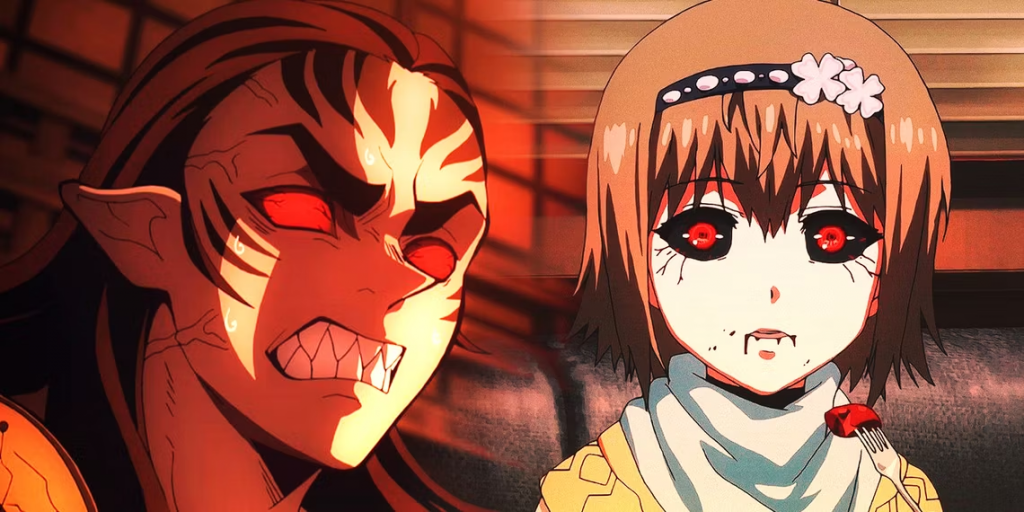
The world of anime is filled with “monster hunter” series that revolve around skilled hunters taking down dangerous creatures. From demon slayers to devil hunters, these shows often depict a clear divide between the hunters and the monstrous beings they encounter. However, some anime series delve deeper into the complexities of these monsters, exploring the presence of their human side and the moral dilemmas faced by the protagonists. Two notable examples are Demon Slayer and Tokyo Ghoul, which captivate fans by delving into the gray areas surrounding their respective monsters.
In both Demon Slayer and Tokyo Ghoul, the demons and ghouls, respectively, possess a human side or at least remnants of their humanity. Unlike the purely monstrous devils in Chainsaw Man, the demons in Demon Slayer and the ghouls in Tokyo Ghoul were once innocent or sympathetic human beings. Even characters like the grotesque hand demon or the arrogant himedere Daki had traces of their former humanity. This human spark buried within them becomes evident to protagonists like Tanjiro Kamado and Ken Kaneki as they confront these creatures. Tanjiro, in particular, is able to sense their innate humanity, causing him to shed tears for the loss of what they once were.

Similarly, Ken Kaneki develops a deep sympathy for both humans and ghouls, having a personal connection to both sides. He realizes that the true evil lies not in the ghouls themselves but in the flawed world they inhabit. Ken becomes horrified by the senseless loss of innocent lives on both sides, recognizing that the distinction between ghouls and humans is not black and white. He redraws the line, dividing individuals based on their innocence or guilt rather than their species. This shift in perspective forms an integral part of Ken’s plan to bridge the gap between the two factions and protect the innocent.
However, while the protagonists of Demon Slayer and Tokyo Ghoul grapple with the moral complexity of their adversaries, the monster hunters they encounter remain largely focused on their duty. Apart from Tanjiro, most monster hunters are unaware or indifferent to the human side of demons and ghouls. Characters like Kureo Mado and Juzo Suzuya from Tokyo Ghoul take pleasure in exterminating ghouls, showing no mercy even to those who are genuinely innocent. Similarly, in Demon Slayer, slayers like Sanemi prioritize their duty over understanding the humanity hidden within the demons they face, refusing to show mercy even to benevolent creatures like Nezuko Kamado.

These contrasting perspectives highlight the tragic divide between the hunters and the hunted in both series. The immense amount of bloodshed on both sides prevents a deeper understanding and empathy from emerging. However, it is through the eyes of open-minded heroes like Ken and Tanjiro that the audience can glimpse the truth behind the violence and hatred. Despite witnessing the human side of demons, Tanjiro continues to fulfill his duty as a slayer, driven by his commitment to protecting his sister Nezuko. However, the sight of the demons’ hidden humanity still brings tears to his eyes, representing the internal conflict he faces.
In the intricate worlds of Demon Slayer and Tokyo Ghoul, the exploration of the human side within their monstrous beings adds layers of complexity and emotional depth to the narratives. It challenges the notions of good versus evil and forces the protagonists to confront their own moral boundaries. As the stories unfold, viewers are left pondering the tragic nature of these creatures and the impact of duty on the fragile connections that exist between them.
We bring out some of the most well-known Tokyo Ghoul Collection, all of which are available at reasonable costs. Visit our link now if you are interested in the Tokyo Ghoul Collection
Tokyo Ghoul Car Floor Mats, Hide Nagachike Car Floor Mats, Anime Car Accessories
Tokyo Ghoul Car Floor Mats, Hikari Kirishima Fan Art Car Floor Mats, Anime Car Accessories


Ken,Touka,Rize,Shu,Yoshimura
